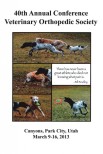Objective: To determine the prevalence of increased radiographic soft tissue opacity in canine stifles with patella luxation in the absence of overt cranial cruciate ligament (CCL) pathology.
Study design: Retrospective case series.
Animal population: A total of 49 client-owned dogs (57 limbs).
Methods: Dogs with patella luxation that underwent arthrotomy with CCL evaluation were included. Dogs were excluded if overt pathology of the CCL was noted during orthopedic examination and/or surgical evaluation. Correlation of increased radiographic soft tissue opacity with age, breed, weight, duration of clinical signs, presence of stifle osteoarthritis, muscle atrophy, and luxation grade were evaluated.
Results: Increased radiographic soft tissue opacity of the stifle was appreciated in 37/57 (65%) stifles. Weight (p = .029) and presence of osteoarthritis (p = .0143) were associated with the presence of increased radiographic soft tissue opacity. For every 1 kg increase in weight there is a 10% increased risk in having this radiographic change. Four of 21 dogs (19%) with long term follow-up were diagnosed with a CCL injury 2, 2.5, 4, and 4.5 years postoperatively. Two of the four dogs (50%) with later CCL injury had increased radiographic soft tissue opacity in the stifle joint when initially presenting for patella luxation.
Conclusion: Increased soft tissue opacity of the stifle joint may be found on radiographs of dogs with patella luxation without overt CCL pathology.
Clinical significance/impact: Increased radiographic soft tissue opacity within the stifle joint is not uncommon in dogs with patellar luxation that do not have overt CCL pathology. Increased radiographic soft tissue opacity alone should not infer pathology of the CCL in dogs with patella luxation.









